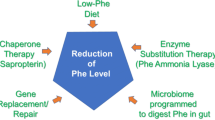Abstract
L-2-Hydroxyglutaric aciduria is a rare inborn error of metabolism, marked by a large and persistent increase of L-2-hydroxyglutaric acid in urine, blood and cerebrospinal fluid (CSF). We present clinical, biochemical and neuroradiological findings of seven Italian patients aged 4–19 years presenting at different stages of the disease. The disorder was characterized by a progressive neurological syndrome with cerebellar and pyramidal signs, mental deterioration, epilepsy and subcortical leukoencephalopathy on magnetic resonance imaging (MRI). We observed a good correlation between the severity of the disease and the extent of lesions on MRI. We report the result of the first positive prenatal diagnosis.
Similar content being viewed by others
Author information
Authors and Affiliations
Additional information
Received: 10 February 2000 / Accepted: 13 April 2000
Rights and permissions
About this article
Cite this article
Moroni, I., D'Incerti, L., Farina, L. et al. Clinical, biochemical and neuroradiological findings in L-2-hydroxyglutaric aciduria. Neurol Sci 21, 103–108 (2000). https://doi.org/10.1007/s100720070104
Issue Date:
DOI: https://doi.org/10.1007/s100720070104




